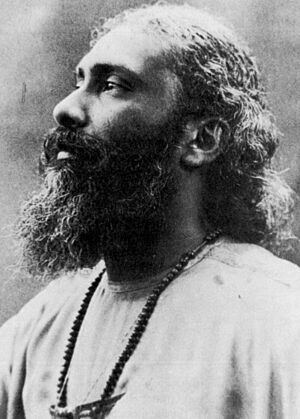Inayat Khan facts for kids
Quick facts for kids Inayat Khan |
|
|---|---|
| عنایت خان رحمت خان | |
 |
|
| Religion | Islam |
| Denomination | Sunni |
| Personal | |
| Born | Inayat Khan Rehmat Khan July 5, 1882 Baroda, Bombay Presidency, British India |
| Died | February 5, 1927 (aged 44) New Delhi, British India |
| Spouse | Pirani Ameena Begum |
| Children | Vilayat; Hidayat; Noor; Khair-un-Nisa Inayat Khan |
| Senior posting | |
| Title |
|
| Successor | Vilayat |
| Religious career | |
| Profession | Musician, Pir, Musicologist |

Universel Murad Hassil, Netherlands
|
|
| Sant and Pir | |
| Venerated in | Inayatiyya; Western Sufism |
| Major shrine | Dargah in Hazrat Nizamuddin, Delhi |
| Influences | Sayyid Abu Hashim Madani |
| Influenced | Universal Sufism |
|
Tradition or genre
|
Chishti, and other major Sufi tariqa |
Inayat Khan (born July 5, 1882 – died February 5, 1927) was an important Indian musician, poet, and thinker. He was a talented singer and played the saraswati vina. He is known for bringing the spiritual teachings of Sufism to Western countries.
In 1914, he started a Sufi order in London. This was based on his family's Sufi traditions. By the time he passed away in 1927, his teachings had spread across Europe and North America. Many books of his teachings were also published.
Contents
Early Life and Family Roots
Inayat Khan was born in Baroda, India, into a noble Mughal family. His family had a rich history. His ancestors were from Central Asia and settled in India a long time ago.
His maternal grandfather was Sangit Ratna Maulabakhsh Sholay Khan. He was a famous Indian classical musician and teacher. People even called him “the Beethoven of India.” Inayat Khan's maternal grandmother was from the royal family of Tipu Sultan of Mysore.
Understanding Sufism
Inayat Khan learned about Sufism from his family's traditions. He also learned from a teacher named Sayyid Abu Hashim Madani. Sufism is a mystical branch of Islam. It focuses on finding a deeper connection with God through spiritual practices.
Inayat Khan was given permission to teach in four main Sufi orders. These included the Chishti order, which was very important to him.
Travels and Spreading Teachings
Inayat Khan traveled to the United States between 1910 and 1912. He went with his brother, Maheboob Khan, and his cousin, Mohammed Ali Khan. Later, he traveled to England, France, and Russia.
During the First World War, he lived in London. This is where he started his Sufi order. After the war, he traveled widely again. Many Sufi centers opened in Europe and the U.S. because of his work. He eventually settled in Suresnes, France, at a special house called Fazal Manzil.
Key Teachings
Inayat Khan's teachings focused on the idea that there is only one God. He also taught that all great religions share a common truth. He believed that the messages from different prophets were all connected.
He spoke about many topics, including religion, art, music, and health. The main goal of his teachings was to help people realize God within themselves. He taught four stages of spiritual study: concentration, contemplation, meditation, and realization.
Ten Sufi Thoughts
Inayat Khan shared ten important principles. These are known as the Ten Sufi Thoughts. They explain the universal spiritual values that were central to his ideas.
- There is One God, the Eternal, the Only Being; none exists save God.
- There is One Master, the Guiding Spirit of all Souls, Who constantly leads followers towards the light.
- There is One Holy Book, the sacred manuscript of nature, the only scripture which can enlighten the reader.
- There is One Religion, the unswerving progress in the right direction towards the ideal, which fulfills the life's purpose of every soul.
- There is One Law, the law of reciprocity, which can be observed by a selfless conscience together with a sense of awakened justice.
- There is One Brotherhood and Sisterhood, the human brotherhood and sisterhood, which unites the children of earth indiscriminately in the Parenthood of God.
- There is One Moral, the love which springs forth from self-denial, and blooms in deeds of beneficence.
- There is One Object of Praise, the beauty which uplifts the heart of its worshippers through all aspects from the seen to the unseen.
- There is One Truth, the true knowledge of our being, within and without, which is the essence of all wisdom.
- There is One Path, the annihilation of the false ego in the real, which raises the mortal to immortality, and in which resides all perfection.
Family Life
In New York, Inayat Khan met Ora Ray Baker, who became his wife. Her Sufi name was Ameena Begum. They had four children together: Vilayat Inayat Khan, Hidayat Inayat Khan, Noor Inayat Khan, and Khair-un-Nisa Inayat Khan.
Death and Lasting Impact
In 1926, Inayat Khan returned to India. He passed away in Delhi on February 5, 1927. He is buried in a special place called a dargah in Nizamuddin, Delhi. This place is open to the public, and people often gather there for musical performances called qawwali.
His teachings continue to inspire many people around the world today.
Images for kids
See also
 In Spanish: Inayat Khan para niños
In Spanish: Inayat Khan para niños
- Inayati Order
- Vilayat Inayat Khan (son)
- Western Sufism
- Zia Inayat Khan (grandson, current president of the Inayati Order)



